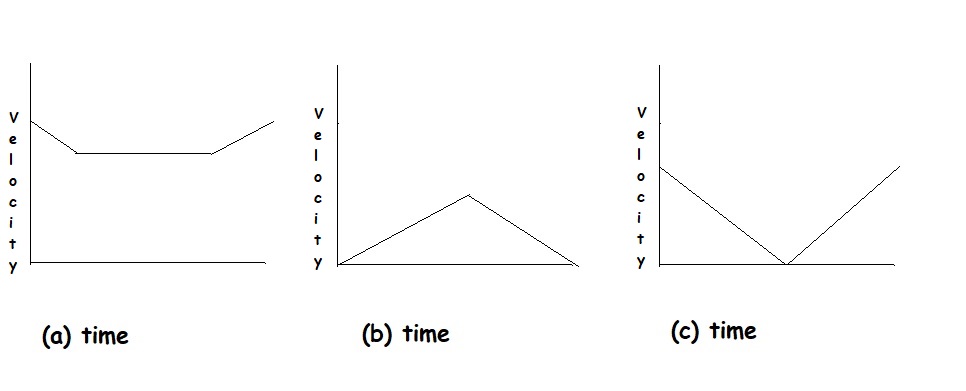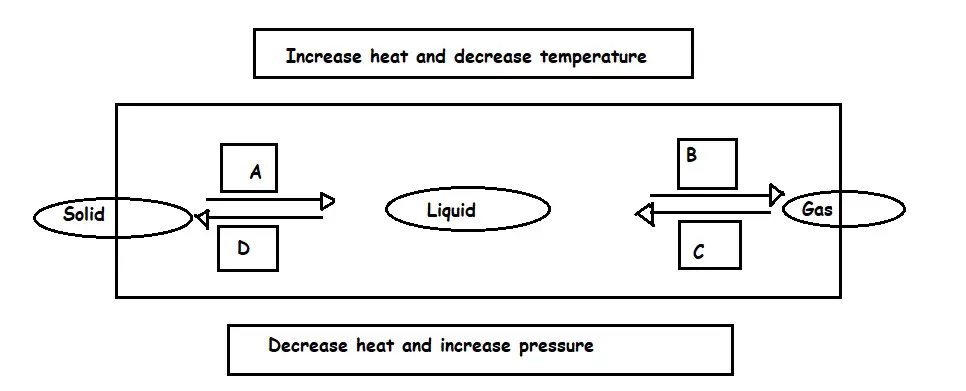Class IX Science First Periodic Examination Sample Question Paper
Class 9 Science | First Periodic Examination
Marks: 80
Time: 3 hours
Total number of questions: Physics 1 to 13; Chemistry 1 to 16; Biology 1 to 14
Physics (27 marks)
Questions 1-5 (1 mark each)
1. The speed of a moving object is determined to be 30m/s. This speed is equal to
(a) 8.3km/h, (b) 108km/h, (c) 500km/h; (d) 0.83km/h
2. Circular motion is accelerated motion. Why?
3. Write the SI unit of below mentioned quantities.
(a) Momentum (b) Acceleration (c) Force (d) Displacement
4. Three velocity time graphs are given below.

Which graph represents the case of
(i) A cricket ball thrown vertically upwards and returning to the hands of the thrower?
(ii) A trolley decelerating to a constant speed and then accelerating uniformly
5. A bus moving along a straight line at 20m/s undergoes an acceleration of 4m/s2. What will be its velocity after 2 seconds?
Directions: In the following questions, as statement of assertion (A) is followed by a statement of Reason (R). Mark the correct choice as:
(a) Both Assertion (A) and reason (R) are true and Reason (R) is the correct explanation of assertion (A)
(b) Both assertion (A) and reason (R) are true but reason (R) is not correct explanation of assertion (A)
(c) Assertion (A) is true but reason (R) is false.
(d) Assertion (A) is false but reason (R) is true
6. Assertion: An object may acquire acceleration even if it is moving at a constant speed.
Reason: With change in the direction of motion, an object can acquire acceleration
7. Assertion: Displacement of an object may be zero even if the distance covered by it is not zero.
Reason: Displacement is the shortest distance between the initial and final position.
Case study (4 marks each)
8. Distance and displacement are two quantities that seem to mean the same but are different with different meanings and definitions. Distance is the measure of ‘how much distance an object has covered during its motion’ while displacement refers to the measure of ‘how far an object is actually from its initial place. Using this data answer the following questions.
(i) Which of the following relation is always true when object moves in straight line?
(a) Distance is always equal to displacement.
(b) Distance is always greater than or equal to displacement.
(c) Distance is always lesser than or equal to displacement.
(d) None of the above
(ii) Kapil travel 20km to North, but then come back to South for 40km to pick up a friend. What is Kapil’s total distance?
(a) 60 km; (b) 80km; (c) 20km; (d) None of the above
(iii) Rahul travels 20km to East but then come back to West for 10km. Find displacement.
(a) 30km; (b) 20km; (c) 10km; (d) None of the above
(iv) Define distance and displacement of particle
9. Speed of an object is the distance covered per unit time and velocity is the displacement cover in unit time. To specify the speed of an object, we require only its magnitude while velocity is the speed of an object moving in a definite direction.
(i) SI unit of speed is
(a) m/s; (b) s/m; (c) m/s2 ; (d) None of these
(ii) Which of the following is true?
(a) Speed is scalar; (b) Velocity is vector; (c) Both a and b; (d) None of these
(iii) To specify speed we require
(a) Magnitude; (b) Direction; (c) magnitude and direction; (d) none of these
(iv) Define speed and velocity of a particle
10. State law of inertia. Explain why some of the leaves may get detached from a tree if we rigorously shake its branch. (2 marks)
11. (a) Differentiate between balanced and unbalanced force. (2 marks)
(b) List any 4 effects of force
12. State Newton’s second law of motion. Also derive the mathematical formula. (3 marks)
13. (a) Derive velocity-time relation
(b) A train is travelling at a speed of 90km/h. Brakes are applied so as to produce a uniform acceleration of -0.5m/s2 Find how far the train will go before it is brought to rest.
Chemistry (25 marks)
Questions 1-5 (1 mark each)
1. What is a pure substance? Give one example. (1 mark)
2. (a) Name SI unit of measuring temperature
(b) Write the boiling point and melting point of water
3. Write any two differences between a compound and a mixture.
4. Write the name of two substances that sublime.
5. Classify the following into pure substance and mixtures
Soil, sodium, sugar, sugar solution, silver, calcium carbonate, air, blood
Questions 6-9 (2 marks each)
6. Name A, B, C and D in the following diagram showing change in its state.

7. To which physical state of matter, do the following statements apply? (2 marks)
a) Incomprehensible, no fixed shape
b) Incomprehensible, high melting point
c) Compressible, no definite volume
d) Incompressible, highly fluid
8. Justify the following statements;
a) When sugar crystals dissolve in water, the level of water does not rise appreciably.
b) We can get the smell of perfume sitting several meters away. (2 marks)
9. (a) Naphthalene balls disappear with time without leaving any solid. Give reason.
(b) Why is ice at 273 K more effective in cooling than water at the same temperature? (2 marks)
10. (a) What is evaporation?
(b) List four factors which affect the rate of evaporation.
(c) Write any one difference between evaporation and boiling. (3 marks)
11. Give reasons
a) We see water droplets on the outer surface of a glass containing ice-cold water
b) Water kept in an earthen pot become cool during summer
c) Wearing cotton clothes in summer is more comfortable (3 marks)
12. (a) What are mixtures?
(b) Which are the two types of mixtures? Explain with examples. (3 marks)
13. (a) What is melting point?
(b) What will be the state of water at (i) 25 degree C (ii) 373 degree C
(c) Convert the following temperatures to the Celsius scale.
(i) 293K (ii) 0 K (3 marks)
Biology (28 marks)
One mark questions
1. Name the following.
a) The scientist who proposed that all cells arise from pre-existing cells
b) The generic material which lies in direct contact with the cytoplasm in prokaryotes.
2. a) What happens when fresh grapes are kept in concentrated sugar solution?
b) Name the plastid which stores starch, oil and protein granules
3. Name the two cell organelles which have their own DNA and ribosomes.
Two mark questions
4. Give reasons.
a) Inner membrane of mitochondria is deeply folded
b) Lysosomes are commonly called cellular house keepers.
5. Draw a well labeled diagram of a chloroplast in section.
6. Differentiate prokaryotic cell and an eukaryotic cell.
7. Define the following terms:-
a) Endocytosis; b) Osmosis; c) Chromosome; d) Plasmolysis
Three mark questions
8. a) Describe the structure of endoplasmic reticulum
b) What crucial role does it play in the liver cells of vertebrates.
c) Define membrane biogenesis.
9. a) Differentiate mitosis and meiosis.
b) The female gamete of a maize plant has 10 chromosomes in their nucleus. What will be the chromosome number in their male gamete and embryo?
10. a) Who discovered Golgi apparatus?
b) Explain its structure
c) List the functions of Golgi apparatus.
11. a) What is plasma membrane made up of?
b) List the functions of plasma membrane.
12. Draw a labeled diagram of an animal cell.
Practical based questions
13. The stain which is commonly used to stain onion peel. (1 mark)
a) phenolphthalein; b) Methylene blue; c) Safranin; d) Iodine solution
14. Choose the correct sequence for preparing a temporary mount of human cheek cell. (1 mark)
(i) Add two or three drops of methylene blue
(ii) Rinse the mouth with freshwater and disinfectant solution
(iii) Put a drop of glycerine on the material.
(iv) Take scraping from the inner side of the cheek.
(v) Spread it on a glass slide.
(a) i, ii, iii, iv, v
(b) ii, iii, iv, v, i
(c) ii, iv, v, i, iii
(d) iv, ii, v, iii, i
